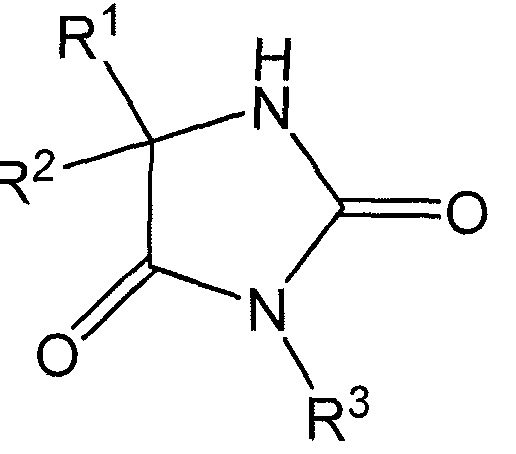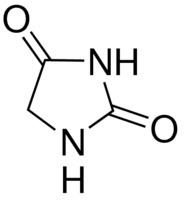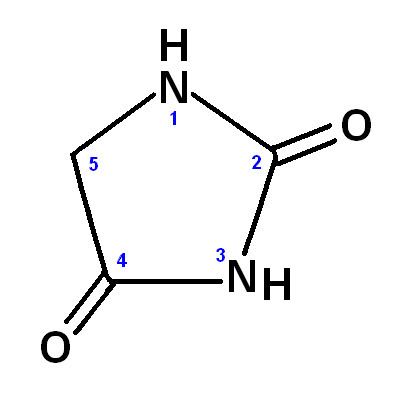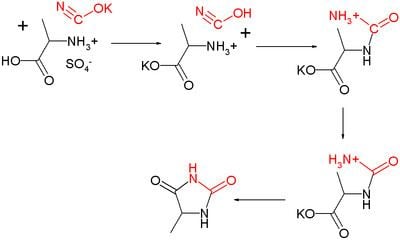Formula C3H4N2O2 | Melting point 220 °C | |
 | ||
Acidic properties of barbiturate and hydantoin
Hydantoin, or glycolylurea, is a heterocyclic organic compound with the formula CH2C(O)NHC(O)NH. It is a colorless solid that arises from the reaction of glycolic acid and urea. It is an oxidized derivative of imidazolidine. In a more general sense, hydantoins can refer to a groups and a class of compounds with the same ring structure as the parent. For example, phenytoin (mentioned below) has two phenyl groups substituted onto the number 5 carbon in a hydantoin molecule.
Contents
- Acidic properties of barbiturate and hydantoin
- Structure of hydantoin
- Synthesis
- Pharmaceuticals
- Pesticides
- Synthesis of amino acids
- Halogenation
- DNA Oxidation to hydantoins after cell death
- References

Structure of hydantoin
Synthesis

Hydantoin was first isolated in 1861 by Adolf von Baeyer in the course of his study of uric acid. He obtained it by hydrogenation of allantoin, hence the name.

Urech in 1873 synthesized 5-methylhydantoin from alanine sulfate and potassium cyanate in what is now known as the Urech hydantoin synthesis The method is very similar to the modern route using alkyl and arylcyanates. The 5,5-dimethyl compound can also be obtained from acetone cyanohydrin (also discovered by Urech: see cyanohydrin reaction) and ammonium carbonate. This reaction type is called the Bucherer–Bergs reaction.

According to the 1911 Encyclopædia Britannica, hydantoin can also be synthesized either by heating allantoin with hydroiodic acid or by "heating bromacetyl urea with alcoholic ammonia". The cyclic structure of hydantoins was confirmed by Dorothy Hahn 1913.

Of practical importance, hydantoins are obtained by condensation of a cyanohydrin with ammonium carbonate. Another useful route, which follows the work of Urech, involves the condensation of amino acids with cyanates and isocyanates:
Pharmaceuticals
Hydantoin group can be found in several medicinally important compounds. In pharmaceuticals, 'hydantoins' most often refer to anticonvulsants; phenytoin and fosphenytoin both contain hydantoin moieties and are both used as anticonvulsants in the treatment of seizure disorders. The hydantoin derivative dantrolene is used as a muscle relaxant to treat malignant hyperthermia, neuroleptic malignant syndrome, spasticity, and ecstasy intoxication. Ropitoin is an example of an antiarrhythmic hydantoin.
Pesticides
The hydantoin derivative Imiprothrin is a pyrethroid insecticide. Iprodione is a popular fungicide containing the hydantoin group.
Synthesis of amino acids
Hydrolysis of hydantoins affords amino acids:
RCHC(O)NHC(O)NH + H2O → RCHC(NH2)CO2H + NH3Hydantoin itself reacts with hot, dilute hydrochloric acid to give glycine. Methionine is produced industrially via the hydantoin obtained from methional.
Halogenation
Some N-halogenated derivatives of hydantoin are used as chlorinating or brominating agents in disinfectant/sanitizer or biocide products. The three major N-halogenated derivatives are dichlorodimethylhydantoin (DCDMH), bromochlorodimethylhydantoin (BCDMH), and dibromodimethylhydantoin (DBDMH).
DNA Oxidation to hydantoins after cell death
A high proportion of cytosine and thymine bases in DNA are oxidized to hydantoins over time after the death of an organism. Such modifications block DNA polymerases and thus prevents PCR from working. Such damage is a problem when dealing with ancient DNA samples.
